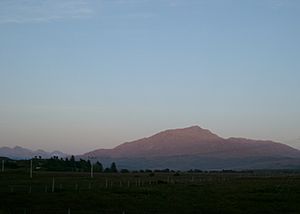Sunart facts for kids
Sunart (pronounced SOO-nart) is a beautiful rural area and community located in the southwest of Lochaber in the Highland region of Scotland. It sits right on the shores of Loch Sunart, a long, narrow sea loch. Sunart is also part of the larger area known as Ardnamurchan.
The main village in Sunart is Strontian, which is found at the very end of the loch. Strontian is an important hub for the area, home to Ardnamurchan High School, the local fire station, police station, and other useful facilities.
Sunart has natural borders that make it quite unique. To the south, it's bordered by the eastern part of Loch Sunart and by a place called Morvern. To the west, you'll find the Ardnamurchan peninsula. To the north, it's bordered by Loch Shiel, another beautiful loch. And to the east, a range of tall hills separates Sunart from the area of Ardgour.
Today, most people get to Sunart by driving through Glen Tarbert, often after taking the Corran Ferry. There's also another road that comes in from Lochailort, passing through Moidart to the north. Even though Sunart might feel a bit remote now, in the past, boats were the main way to travel in the West Highlands. This meant Sunart was very connected to the economy and culture of Scotland's west coast.
Most of the people living in Sunart live in small settlements along the northern shore of Loch Sunart. This area faces south, getting lots of sunshine. The land further inland, including the shore of Loch Shiel, is mostly rough, hilly country. You'll find a lot of moorland, peat bog (wet, spongy ground), and woodlands there. The biggest hill in the area is Beinn Resipol, which is known as a Corbett (a type of Scottish mountain).
The main way people in Sunart make a living is through tourism. Many visitors come to enjoy the stunning scenery and outdoor activities. There's also some salmon fish-farming in the loch, where salmon are raised for food.
Amazing Wildlife in Sunart
Sunart is famous for its incredible variety of wildlife. It's home to some of the best remaining parts of the ancient temperate Atlantic oak forest. This type of forest once covered much of the west coast of Scotland, Wales, Cornwall, and Brittany, but now only small patches are left. These forests are very special and important for many plants and animals.
Loch Sunart itself is also full of life, with a rich variety of flora (plants) and fauna (animals). In the past, catching salmon and sea trout was a popular activity for local hotels, but like in many parts of Europe, the number of fish swimming up the rivers in spring and summer has decreased.
Sunart is believed to have the widest variety of fungi (like mushrooms), lichen (small plant-like growths), and bryophyte (mosses and liverworts) species in all of Europe! This is because the area has a mild, wet oceanic climate, which is perfect for these types of organisms to grow.
Because of its unique natural environment, Sunart has been named a Special Area of Conservation. This means it's a very important place for nature and is protected.
There's also a big effort underway to remove Rhododendron ponticum from the area. This plant is an invasive introduced species, meaning it's not native to Scotland and can take over habitats, harming the local plants and animals.
Places to Explore in Sunart
Sunart is made up of several small communities and interesting spots. While Strontian and Salen are two of the main villages, other places include:
- Achnanellan, Anaheilt, Ard Airigh, Ardery, Ardnastaing, Ariundle
- Drumnatorran
- Glenhurich, Gorstanvorran
- Polloch
- Resipole
- Scamodale, Scotstown
See also


